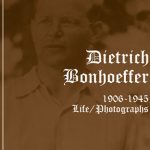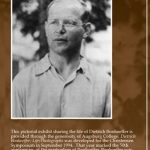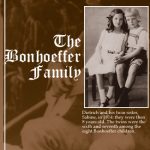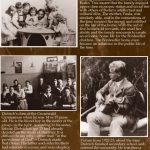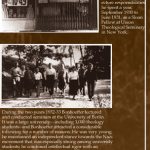Dietrich Bonhoeffer: Life/Photographs was developed for the Christensen Symposium in September 1994. That year marked the 50th anniversary of the martyrdom of Bonhoeffer. Bonhoeffer was courageous and one of the true heroes of the 20th century.
The Dietrich Bonhoeffer Display is no longer available for travel.
Click to view the full-sized image.
Panel B1
Dietrich and his twin sister, Sabine, in 1914: they were then 8 years old. The twins were the sixth and seventh among the eight Bonhoeffer children.
Panel B2
Bottom left photo
Dietrich’s class at the Grunewald Gymnasium when he was 14 or 15 years old. He is the blond boy in the center of the group on the right. According to his sister, Sabine, Dietrich at age 15 had already decided on the study of theology. It is difficult to say why—other than “in the providence of God”—Dietrich made that choice. His father and older brothers had interests in science and were skeptics in matters of religion. At any rate, when this picture was taken Dietrich Bonhoeffer had already decided on the study of theology.
Top left photo
The Bonhoeffer family provided an unusually positive environment for Dietrich’s childhood and youth. The father, Dr. Karl Bonhoeffer, was one of the leading academicians at the University of Berlin. This meant that the family enjoyed upper class economic status and social ties with others of Berlin’s intellectual and cultural elite. The mother, Paula, was similarly able, and in the conventions of the time focused her energy and intellect on the life of the home. With the aid of five household servants, she used her ability and the family resources to create an enviable home life for the Bonhoeffer children. The Bonhoeffer home even became an influence in the public life of the time.
The picture shows Paula with the children when they were probably 4 to 14 years old. Dietrich is second from the right. Paula and Karl did not want to entrust their children to the public schools when they were at an early and impressionable age. There was a saying in the family that German children had their backs broken twice, first at school and later in the army. So Paula had a spacious school room in the home where she and a governess provided “home schooling” for the first year(s) of the children’s education.
Bottom right photo
Picture from 1922-23, about the time Dietrich finished secondary school and entered the university. He was then a year ahead of his age group.
Dietrich was the best musician in a family that enjoyed a good deal of music in their family gatherings. He played the piano well. He composed a cantata while in secondary school on a favorite verse from Psalm 42—“My soul is cast down within me, therefore I remember thee.” Says his biographer, “in his boyhood and youth it was music that gave him a special position at home and among his fellow students.”
Panel B3
Top photo
Bonhoeffer received the Ph.D. at age 21 from the University of Berlin, and he was admitted to that faculty at age 24. Before beginning lecture responsibilities he spent a year, September 1930 to June 1931, as a Sloan Fellow at Union Theological Seminary in New York. He made some new friends, added to his already considerable international perspective, gained a new respect for the social dimension of the Christian gospel, and—most strikingly—in company with an African American friend and fellow student at Union Seminary spent considerable time in Harlem. This picture shows one of Harlem’s store-front churches. Dietrich participated in worship and youth work in the large Abyssinian Baptist church.
He wrote:
For more than six months, I’ve been almost every Sunday lunchtime, about twenty to three, to one of the great Negro Baptist churches in Harlem, … have heard the gospel preached in the Negro churches.
Bottom photo
During the two years 1932-33 Bonhoeffer lectured and conducted seminars at the University of Berlin. It was a large university—including 1,000 theology students—and Bonhoeffer attracted a considerable following for a number of reasons. He was very young; he maintained an independent stance towards the Nazi movement that was especially strong among university students; he combined intellectual rigor with an emphasis on some concrete issues of Christian discipleship, like peace; and he had informal times with his students at evenings in the Bonhoeffer home and with excursions into the country. It was during these informal times that he experimented with ideas and practices of Christian community that he later expressed in his book Life Together (1938). The picture above is of Bonhoeffer with some of his Berlin students during one of their trips into the countryside.


